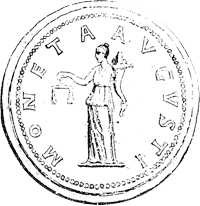Romulus and Remus




ANONYMOUS. Didrachm (Circa 265 BC). Rome.
Obv: Diademed head of young Hercules right, with lion skin around neck; club on shoulder.
Rev: ROMANO.
She-wolf standing right, head left, suckling the twins Romulus and Remus.
Crawford 20/1; HN Italy 287; RBW 23.
The reverse of this Didrachm evokes one of the most widely attested legends about the foundation of Rome, faithfully reproduced from the famous sculpture preserved in the Capitoline Museums. Rome's earliest bronze and silver coinage dates not earlier than the end of the 4th century BC. Produced initially in small quantities, they follow the pattern and weight values of Neapolitan coinage, so they are traditionally called 'Romano-Campananian' series. This occurred mainly after the stipulation of the 'foedum aequum', an agreement sanctioned between Rome and Neapolis in 326, at the time of the Second Samnite War, which marked the beginning of the Roman conquest of southern Italy. The period in which Rome began to produce coinage, between the second conflict with the Samnites until the end of the Punic Wars, coincides with the most intense phase of Roman expansion, implemented through the foundation of colonies and a widespread network of alliances. These issues responded to the need to meet the costs of military enterprises and subsequent public works in occupied territories. The myth of the she-wolf suckling the twins is the result of several elaborations by various authors over the centuries, and it was only in the Augustan age that it took on the definitive form that has been handed down to us, mainly by Titus Livius. The historian tells of Aeneas who landed in Lazio and his descendants, up to Numitor, king of Alba, who was deposed by his brother Amulius. The latter had Numitor's sons killed and forced his only daughter, Rhea Silvia, to become a vestal, so that she would remain a virgin and not bear a son who might one day take revenge and reclaim the throne he had usurped. The vestal virgin was raped and gave birth to twins. In an attempt to save herself, she claimed that the father of her illegitimate offspring was Mars. However, Rhea Silvia was condemned and imprisoned, while the twins were placed in a basket and abandoned on the waters of the Tiber. According to Livius, divine will caused the river to overflow and forced the servants to leave the basket in a pool near the ficus Ruminalis (in the Velabrum). Here, a thirsty she-wolf, attracted by their cries, offered to suckle them and was noticed by the king's herdsman Faustulus, who took them to be raised by his wife.
Condition: Near extremely fine.
Weight: 7.01 g.
Diameter: 22 mm.
Obv: Diademed head of young Hercules right, with lion skin around neck; club on shoulder.
Rev: ROMANO.
She-wolf standing right, head left, suckling the twins Romulus and Remus.
Crawford 20/1; HN Italy 287; RBW 23.
The reverse of this Didrachm evokes one of the most widely attested legends about the foundation of Rome, faithfully reproduced from the famous sculpture preserved in the Capitoline Museums. Rome's earliest bronze and silver coinage dates not earlier than the end of the 4th century BC. Produced initially in small quantities, they follow the pattern and weight values of Neapolitan coinage, so they are traditionally called 'Romano-Campananian' series. This occurred mainly after the stipulation of the 'foedum aequum', an agreement sanctioned between Rome and Neapolis in 326, at the time of the Second Samnite War, which marked the beginning of the Roman conquest of southern Italy. The period in which Rome began to produce coinage, between the second conflict with the Samnites until the end of the Punic Wars, coincides with the most intense phase of Roman expansion, implemented through the foundation of colonies and a widespread network of alliances. These issues responded to the need to meet the costs of military enterprises and subsequent public works in occupied territories. The myth of the she-wolf suckling the twins is the result of several elaborations by various authors over the centuries, and it was only in the Augustan age that it took on the definitive form that has been handed down to us, mainly by Titus Livius. The historian tells of Aeneas who landed in Lazio and his descendants, up to Numitor, king of Alba, who was deposed by his brother Amulius. The latter had Numitor's sons killed and forced his only daughter, Rhea Silvia, to become a vestal, so that she would remain a virgin and not bear a son who might one day take revenge and reclaim the throne he had usurped. The vestal virgin was raped and gave birth to twins. In an attempt to save herself, she claimed that the father of her illegitimate offspring was Mars. However, Rhea Silvia was condemned and imprisoned, while the twins were placed in a basket and abandoned on the waters of the Tiber. According to Livius, divine will caused the river to overflow and forced the servants to leave the basket in a pool near the ficus Ruminalis (in the Velabrum). Here, a thirsty she-wolf, attracted by their cries, offered to suckle them and was noticed by the king's herdsman Faustulus, who took them to be raised by his wife.
Condition: Near extremely fine.
Weight: 7.01 g.
Diameter: 22 mm.


